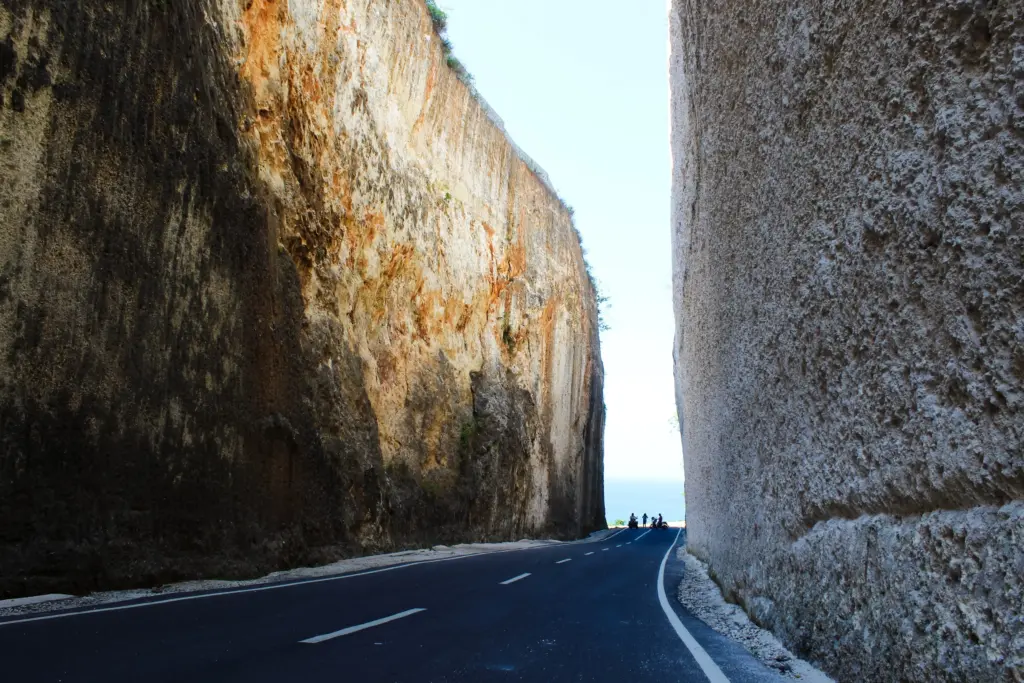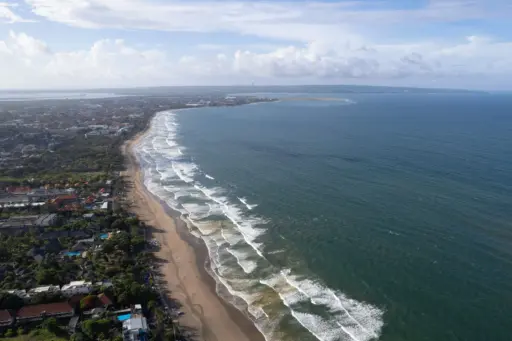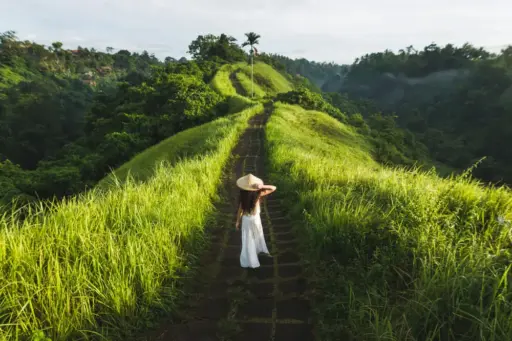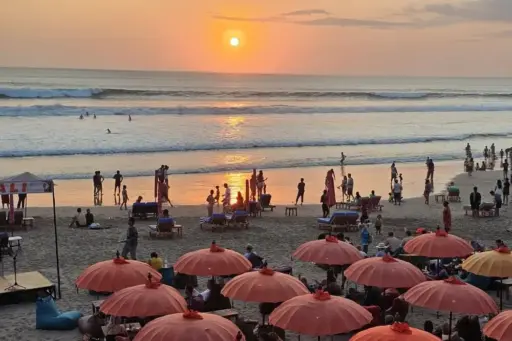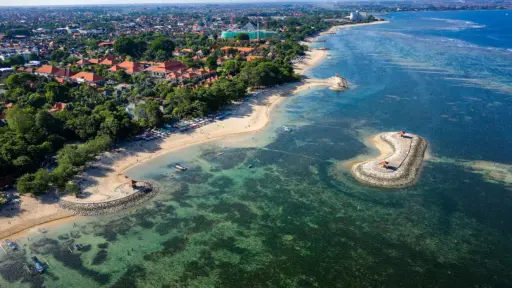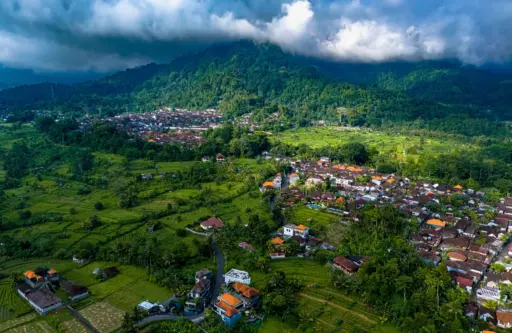Why Uluwatu Stays with You
Uluwatu sits at the southern tip of Bali on the Bukit Peninsula, where pale limestone cliffs fall into a bright, restless ocean. The first thing you feel here is space. Roads roll over low hills, wind past temples and frangipani trees, and end at dead-quiet coves hidden below the cliffs. The second thing you notice is contrast. A simple warung serves a perfect plate of nasi goreng two minutes from a designer restaurant. A surfer paddles into a heavy reef break while a couple clinks glasses at a cliff-top bar. Uluwatu rewards slow mornings, active afternoons and unhurried evenings. It is less about rushing from sight to sight and more about finding your beach, your rhythm and your sunset.
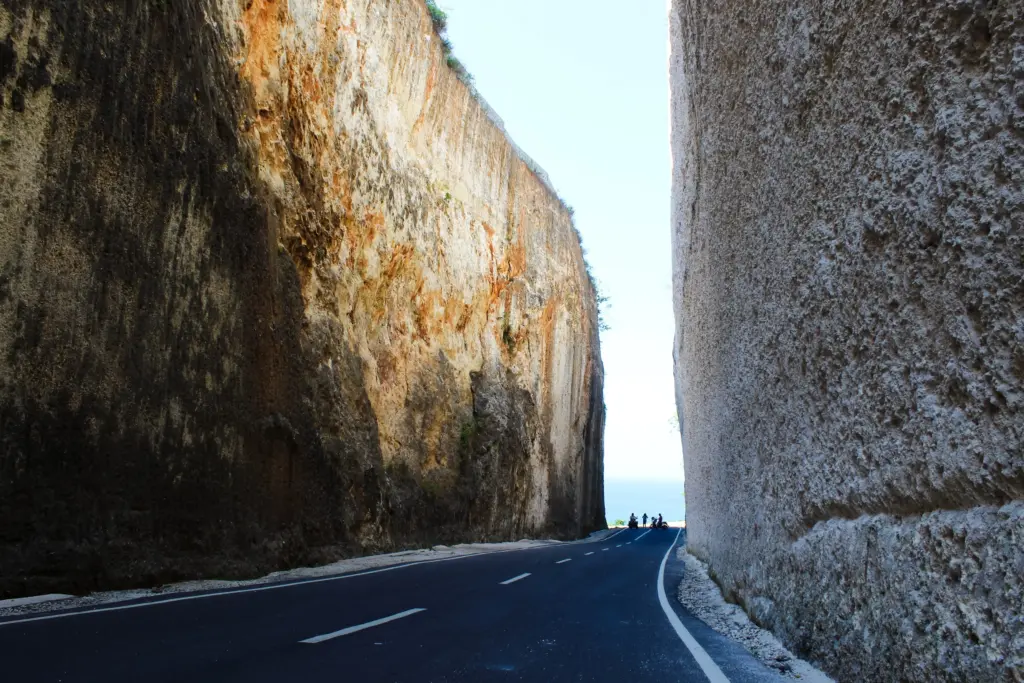
People come for different reasons. Some come for the surf. Some for the temple on the edge of the world. Some for the villas that hang over the ocean and the restaurants that take local produce seriously. Others come to feel far from Bali’s busy north. Uluwatu offers quiet when you want it and energy when you do not. That balance is what keeps travellers returning.
What People Came to Uluwatu for
Surf culture is part of the DNA here. The Uluwatu break, reached through a cave at Suluban, is a rite of passage for experienced surfers and a thrilling show for everyone else. The list of waves within a short drive reads like a greatest hits album: Padang Padang, Bingin, Impossibles, Dreamland and Balangan. The setting is just as important as the surf. Cliffs create natural balconies for sunset bars and restaurants, and the geography makes each beach feel like a small world of its own.
Culture gives the region depth. Pura Luhur Uluwatu (Uluwatu Temple), one of Bali’s most important sea temples, sits 70 metres above the water and hosts a nightly Kecak dance as the sky turns orange.
Wellness has grown here too. Beachside yoga decks, ice baths at sunset and cliff-top spas provide calm between beach days.
Food is now a reason to visit on its own. Cafes take coffee seriously, chefs play with Indonesian flavours, and seafood comes straight from nearby Jimbaran and Pandawa waters.
The Good and the Not-So-Good
Uluwatu is generous with scenery. You get clifftop views, pocket beaches, warm water and skies that change colour every evening. The atmosphere is relaxed, and the scale is human. It never feels like a city. Eating well is effortless. Sleep options range from surf shacks to suites with private pools.
The trade-off is access. Many beaches require steep steps and a patient attitude. You will also need wheels. A scooter or a private driver makes the area simple. Without either, you spend more time waiting than wandering. Nightlife exists, but the scene is smaller and more spread out than in Seminyak or Canggu. If you want big shopping streets, this is not your place.
When to Visit and How the Weather Feels
The dry season from May to September brings blue skies, lower humidity and steady trade winds. This is the best window for clean swell on the west-facing breaks. Water temperatures hover in the mid-20s Celsius, and evenings cool off on the cliffs.
The wet season from November to March is greener and quieter. Showers tend to arrive in bursts. You will still get beach time, but you plan around the rain and the wind.
Shoulder months in April and October often feel like a sweet spot for both weather and crowds.
Getting There and Getting Around
From Ngurah Rai International Airport, Uluwatu is roughly 45 to 60 minutes by car, depending on traffic and where you are staying. The area spreads across Pecatu, Bingin, Padang Padang, Balangan and Ungasan, so distances on the map can be misleading. Hire a scooter if you are confident, and wear a helmet. If you prefer comfort, book a car with a driver for half-day or full-day exploring. Taxis and ride-hailing apps work for point-to-point trips, although coverage late at night can be patchy near the quieter beaches. Keep small cash for beach access fees, temple sarong hire and parking.
The Beaches : Coves, Reefs and Clifftop Stairs
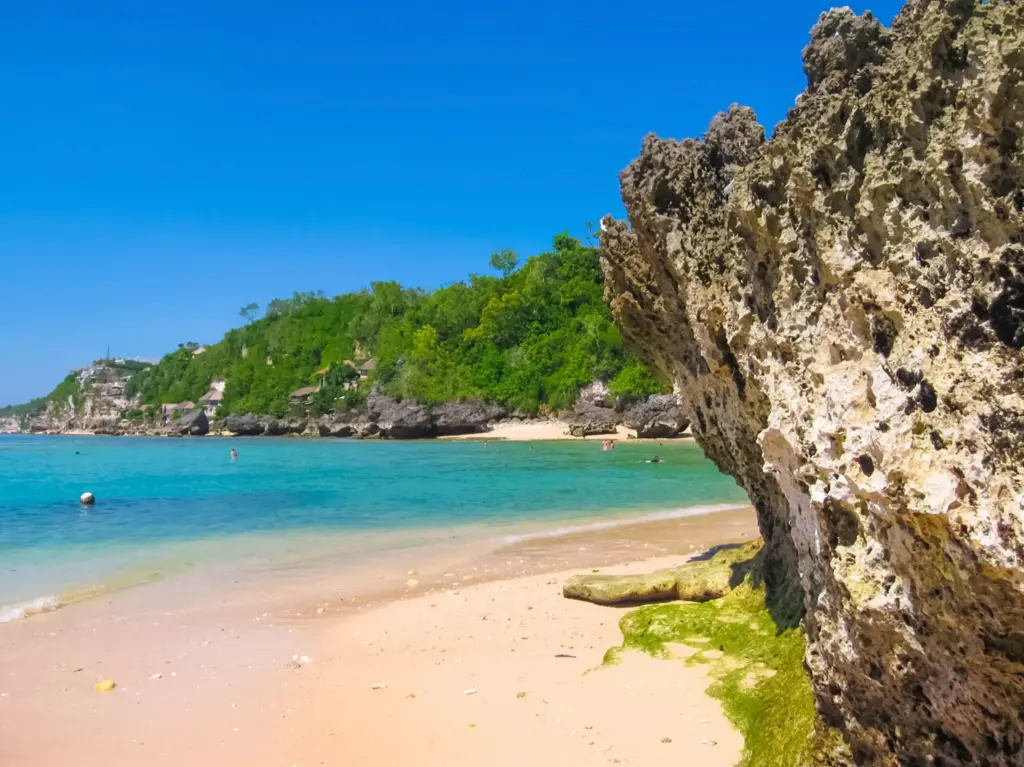
Padang Padang is the postcard. A narrow rock corridor opens to golden sand, clear shallows and a famous reef break outside the lagoon. Early mornings are calm for a swim, while afternoons draw surfers and day trippers.
Bingin is a charming amphitheatre of steps, balconies and surf shacks that tumble down to a narrow strip of sand. At low tide, the reef grows a honeycomb of pools, and the beachfront grills whole fish as the sun drops.
Suluban, also called Blue Point, is pure drama. You walk down through cafes and board racks, step into a cave, and watch the ocean glow at the opening. It is better for surfing and photography than casual swimming, and sunset from the clifftop decks is hard to beat.
Dreamland is broad and accessible, with loungers, snacks and a shore break that changes with the season. Families appreciate the space, and bodyboarders like the punchy waves.
Balangan is a long crescent of pale sand backed by palms and a reef that draws intermediates and longboarders. It still feels timeless at sunrise when fishermen mend nets and the water lies glassy.
Nyang Nyang is the wild card. A long, quiet strand reached by a steep track, it is a place to walk, beach-comb and listen to the sea. Swimming is for confident ocean lovers only. Thomas Beach is easier and gentler, a pocket of soft sand with small warungs and a friendly lineup on mellow days.
Farther down in Ungasan, Melasti and Pandawa offer white sand, turquoise water and easier access by road carved into the cliffs. These beaches face south and east, so they are good bets when the west side is windy.
Uluwatu Restaurants and Cafes
Uluwatu’s dining scene blends laid-back beachside warungs with polished cliff-top restaurants, offering flavours as diverse as the views. From sunrise coffee and smoothie bowls to fresh seafood grilled steps from the sand, every meal feels tied to the ocean. Cafes, bistros and fine-dining spots use local produce with creativity, giving travellers plenty of reasons to linger between surf sessions and sunsets. Here are some of the best places to eat in and around Uluwatu.
Single Fin (Suluban) – Single Fin is a clifftop perch with a split personality. Mornings feel like a bright cafe with espresso, smoothie bowls and surfers below the deck. Afternoons turn into a lazy watch party for the lineup. By sunset, the music lifts and the whole place becomes a social balcony over the sea. The menu is simple but well executed, with bowls, tacos, salads and seafood. The views are the reason to come, yet the team keeps the food and drinks consistent. Sunday sessions are famous, so arrive early if you want a front-row table.
Mana Uluwatu – Mana blends open-air design with a kitchen that champions fresh produce. The dining room looks over jungle and ocean, and the menu travels lightly between wood-grilled fish, vegetable-forward plates and Balinese staples treated with care. Cocktails use tropical fruits and house infusions without becoming fussy. Breakfast is strong, with sourdough, eggs, breakfast tacos and bright smoothies. Service is relaxed, and the setting makes everything taste better. It is an easy place to spend two hours without noticing.
Suka Espresso (Uluwatu) – Suka Espresso brings Australian coffee culture to the Bukit with competent baristas and a menu that reads like a greatest hits of brunch. Avocado on sourdough sits beside shakshuka, eggs Benedict and miso mushrooms. Lunch leans toward colourful bowls, burgers and fish tacos. The room is clean and bright, and the staff move quickly without rushing you. It suits both a quick pre-beach caffeine run and a longer meal with friends. Portions are fair, and there is a good balance between healthy and comforting.
Drifter Cafe and Gallery (Uluwatu) – Drifter is a surf shop, cafe and small gallery under one roof. You order a flat white or cold brew and end up browsing books on surf history and photography while your breakfast arrives. The kitchen leans fresh and light, with acai bowls, tofu scrambles, salads and wraps. There are indulgent options too, but the draw is the mix of community and curation. It feels like the living room of the local surf scene. If you want to pick up wax, a new fin or a coffee table book, you do that after lunch.
The Cashew Tree (Bingin) – Hidden on a tight corner and a short walk from Bingin steps, The Cashew Tree is a leafy canteen that feeds everyone from early yoga groups to families. Expect balanced plates with grains, greens and proteins presented without fuss. Smoothies and cold-pressed juices keep the heat at bay, and the kitchen prides itself on house-made dressings and sauces. Evenings often bring live acoustic sets, which give the space a garden-party mood. It is the kind of place you return to twice in a week because it makes you feel good.
La Baracca (Uluwatu) – La Baracca is cosy and rustic, with vintage lamps, wooden tables and staff who greet you like regulars. The pizzas are thin and well blistered, the pastas taste like someone cared, and small plates arrive with proper seasoning. You can share antipasti, sip a light Italian wine and stretch dinner into a conversation. There is nothing experimental here, which is the point. It is a faithful Italian kitchen that respects familiar flavours and does them consistently well.
Gooseberry (Uluwatu) – Gooseberry is a bright, polished space tucked off the main road near Padang Padang. The menu blends bistro comforts and lighter coastal cooking, so you can choose a steak frites or a citrusy ceviche and be equally happy. Brunch is popular for pancakes, eggs and fresh pastries. The bar team pays attention to detail, and the desserts are worth saving room for. Service is smooth without being formal. It feels like a city restaurant that found a sunny home near the sea.
Ours Uluwatu (Padang Padang) – Ours has a Scandinavian-meets-tropical look and a menu that treats seasonal produce with respect. Dishes have clean flavours and careful textures, from crisp salads to slow-cooked mains. The room is light and plant-filled, which suits daytime dining, while evenings feel intimate with candles and low music. It works equally well for a casual lunch in sandals or a date night after sunset at the beach. Portions are sensible, and the kitchen avoids heavy hands with sauces.
The Loft Uluwatu (Uluwatu) – The Loft balances bright vegan options with satisfying non-vegan plates, so mixed groups eat happily here. Colourful bowls sit beside burgers and wraps, and breakfast runs all day for those who keep beach hours. The room is open and friendly, and the service is used to the ebb and flow of surfers and families. Portions lean generous. If you need a place to refuel that suits most diets without drama, this is an easy answer.
Ulu Garden (Uluwatu) – Ulu Garden is exactly what the name suggests, a relaxed garden restaurant that takes care of the basics. The menu crosses Indonesian favourites with international comfort food, so a table can share nasi campur, satay, salads and pasta and everyone is satisfied. Live music appears a few nights each week and keeps the mood light. Pricing is kind, families feel welcome, and the staff keep things moving even when the garden fills up.
El Kabron Cliff Club (Pecatu) – El Kabron sits on the edge of the cliff with a round pool that looks like a blue coin dropped into the rock. The kitchen focuses on coastal Spanish flavours, so you see paella, octopus, croquetas and simple grilled seafood. Sunbeds and daybeds create a lazy afternoon scene that turns into a golden hour ritual. It is a place where the view does most of the talking, and the team supports it with chilled service and competent cooking. Dress for sun protection, then stay for the second sunset drink.
Dugong at Suarga Padang Padang – Dugong is the signature restaurant at Suarga, an eco-minded resort built with reclaimed wood and natural ventilation. The dining room overlooks the reef, and the kitchen leans into Indonesian produce and spice in a refined way. Expect line-caught fish, local greens, heritage rice and careful sauces, plated with restraint. The room feels airy and crafted rather than flashy. If you want a dinner that connects place, produce and design, this is a strong choice.
The Cave by Chef Ryan Clift (Pecatu) – Hidden within a limestone cavern at The Edge, The Cave offers a tasting menu in a true underground setting. The experience is theatrical, with lighting that plays off the rock and a sequence of small courses that change with the season. The cooking is modern and technique-driven without losing flavour along the way. It feels special from the first step down the stairs. Come for an occasion, keep an open mind and enjoy a meal that you will talk about later.
Ulu Cliffhouse (Uluwatu) – Ulu Cliffhouse is a day-to-night venue with clean lines, a long pool, and several terraces that stare at the horizon. The food is Mediterranean-leaning with plenty of seafood, salads and grilled dishes. Drinks are crisp and beach-friendly. Afternoons drift into sunset with a soundtrack that rises gently. You can book a daybed and settle in or come for dinner and let the evening run. It is polished without feeling stiff.
Sundays Beach Club (Ungasan) – You reach Sundays by inclinator down a cliff to a pale, private stretch of sand. The restaurant sits just above the water with a menu of coastal hits: grilled fish, salads, pizzas and cold drinks. Kayaks and paddleboards are available when the water is calm. As the light softens, the staff set up bonfires on the beach. It is an easy place to spend an entire day because everything you need is within a few steps of the sea.
Mason Uluwatu (Uluwatu) – Mason delivers a restrained, confident take on wood-fire cooking. House-made charcuterie, simple grilled vegetables and well-sourced meats make up a menu that reads short and eats well. The room is pared back in the best way, with concrete, timber and soft light. Cocktails are clean and direct. It feels adult without being formal, which makes it a smart pick for a proper dinner after a week of beach food.
Warung Local (Uluwatu) – Warung Local gives you a build-your-own nasi campur line where you point to what looks good and a plate appears. Dishes feel homemade, from turmeric-stained fish to long-cooked greens and sambal that carries real flavour. Prices are gentle, and service is fast. It is a simple system done with care, and it gives you a way to taste across Bali’s everyday food in one meal.
Bingin Bagus Seafood – Bingin Bagus runs a humble grill steps from the sand. You choose your fish by weight, add sides of rice, greens and sambal, and the team cooks over coconut husk coals. Sunset eats up the sky while plates arrive smoky and straightforward. This is not fine dining. It is the taste of the sea handled with respect and served where you can still hear it.
Il Ristorante – Luca Fantin at Bulgari (Pecatu) – At Bulgari Resort, Il Ristorante presents a refined Italian tasting menu that marries premium ingredients with a light hand. The room is low-lit and elegant, the service is quiet, and the kitchen moves confidently through classic techniques and seasonal ideas. Wine pairings are thoughtful. It is a destination dinner, best enjoyed unrushed.
Rock Bar, AYANA (Jimbaran) – Rock Bar sits on natural rock formations at the base of a cliff. You descend by inclinator and take a seat as waves hit the lava stone. The menu leans to drinks and light bites, and the reason to come is the theatre of sunset. Staff manage the flow of people well, and the setting does the rest. It is outside strict Uluwatu but still part of the Bukit circuit and worth a single visit.
Yuki (Uluwatu) – Yuki brings a contemporary edge to Japanese dining in Uluwatu, pairing clean, minimalist interiors with food that celebrates freshness and precision. The menu moves from delicate sushi and sashimi to inventive small plates and smoky, charred dishes from the grill, each crafted with a light, balanced touch. Cocktails draw on Japanese flavours, while the sake list invites exploration. The setting is warm and stylish without feeling formal, making it just as inviting for a romantic evening as it is for a shared feast with friends against the backdrop of Bali’s southern coast.
Bars and Nightlife
Uluwatu’s bars and nightlife take full advantage of the region’s dramatic clifftop setting and ocean views. Evenings often begin with golden-hour cocktails overlooking the surf and roll into live music, DJ sets, or relaxed beach bonfires. From iconic sunset institutions to stylish cliff clubs and colourful local hangouts, there is a venue to match every mood. Here are some of the best spots to enjoy a drink and the after-dark energy of Uluwatu.
Single Fin (Suluban) – Single Fin is the original sunset institution. Golden hour pours across the decks, the DJ lifts the tempo, and surfers exit the water below. Drinks are simple and cold. The energy is friendly and open, and you can decide whether to make it an early evening stop or let it roll late. Come midweek for a calmer vibe or Sunday if you want the full scene.
Ulu Cliffhouse (Uluwatu) – Ulu Cliffhouse carries an easy rhythm from daybeds to dinner to a danceable night. Programming brings international and local DJs without drowning conversation. Cocktails are balanced, and the staff keep an eye on the details. The venue’s layout means you find your own corner whether you want a loud night or a social sunset.
Savaya Bali (Pecatu) – Savaya is a glass-and-stone dayclub built on the edge of a cliff with a big-room sound system and visiting headliners. The design frames the ocean view, and the production values are high. It is not subtle, and that is the appeal. If you want a proper party with international bookings, this is where the Bukit does scale.
Hatch Uluwatu (Uluwatu) – Hatch is a colourful, multi-level bar that feels handmade in the best possible way. The crowd is mixed, the music rotates through live bands and DJs, and the space works for both a group night and a spontaneous drink. Drinks are fair, and the staff keep things light. It is less polished than the clifftop clubs and more community-minded.
El Kabron Cliff Club (Pecatu) – El Kabron trades on its position and turns sunset into a ritual. The pool glows, the sea stretches, and the staff keep champagne cold and sangria flowing. After dark, the mood settles into a lounge feel. It is a place to dress up a little and take photos you will actually print.
Oneeighty at The Edge (Pecatu) – Oneeighty is famous for its glass-bottom sky pool that hangs over the cliff. By day it plays like a luxury dayclub. By late afternoon, it becomes a refined perch for a last swim and a serious cocktail. Service is attentive, and the kitchen is better than a view this strong requires. Booking helps, especially in peak season.
The Bench Brewery (Uluwatu) – A craft beer destination that combines a laid-back tropical vibe with a serious passion for brewing. Set in a stylish yet casual space, it offers a rotating selection of house-brewed beers alongside guest taps, covering crisp lagers, hoppy IPAs, and smooth stouts. Visitors can sample tasting paddles to explore different styles or settle in with a pint paired with hearty pub-style food. The open, social layout encourages conversation, while the friendly team is happy to share brewing insights. It is a must-visit for beer lovers looking to enjoy something local and full of character in Uluwatu.
Where to Stay : Villas, Resorts and Hotels
Uluwatu and the wider Bukit Peninsula offer stays that match every travel style, from ultra-luxury cliffside resorts with private pools to charming boutique villas and budget-friendly surf lodges. Many properties make the most of sweeping ocean views, lush gardens, and easy access to the area’s best beaches. Whether you want seclusion, romance, or a social base for exploring, Uluwatu has accommodation to suit. Here are some of the top places to stay in the region.
Alila Villas Uluwatu (Pecatu) – Alila Villas is a study in calm. Villas sit on a plateau above the sea, arranged to catch the breeze and the horizon. Architecture is minimalist, materials are natural, and each villa has a private pool that seems to spill into the sky. Service is unintrusive and precise. The on-site restaurants treat local ingredients with respect, and the famous sunset cabana becomes a living postcard each evening. It suits couples and anyone who values space, design and quiet.
Bulgari Resort Bali (Pecatu) – Bulgari blends Italian design with Balinese craft and gives every villa a private garden and plunge pool. Stone paths wind through tropical landscaping to an inclined elevator that drops to a private beach. Dining ranges from refined Italian to relaxed Indonesian, and the bar looks over nothing but blue. The service culture is polished. It is a resort where you can stay for days and never need to leave the cliff.
Six Senses Uluwatu (Pecatu) – Six Senses sits on a dramatic clifftop with villas and suites that look directly into the horizon. Wellness is built into the daily rhythm, from morning yoga to a strong spa program and healthy menus that still feel generous. Sustainability is more than a label here, woven through design and operations. The feel is secluded without being remote. Sunsets are enormous, and the stars are bright once the music elsewhere fades.
The Ungasan Clifftop Resort (Ungasan) – The Ungasan feels like a small community of private villas along a shared cliff. Each villa has a different personality, but all share ocean views, large pools and space to spread out. Down below, Sundays Beach Club gives guests an easy way to claim a stretch of sand. Staff handle details well, from breakfast served in your villa to sunset transport to the beach. It works for families and groups who want privacy without isolation.
The Edge Bali (Pecatu) – The Edge sits close to the cliff with a handful of villas, Oneeighty dayclub and an outlook that steals your attention every time. Villas are spacious and designed for gathering, with generous common areas and private pools. The property feels intimate, and service moves quickly. Dining is stronger than you might expect for a small resort. It is ideal for honeymoons, celebrations and design-loving travellers who want to stare at the horizon.
Anantara Uluwatu (Pecatu) – Anantara terraces down the hill above Impossibles with rooms and suites that face the ocean. Some units have private pools or hot tubs, and all share access to a split-level pool and a small beach below when tides allow. The resort hosts weddings and has a friendly, capable team. Location is central for Padang Padang and Bingin dining, so you can easily eat out and wander back by scooter or car.
Radisson Blu Bali Uluwatu (Pecatu) – Radisson Blu delivers a strong mid-to-upper option with large rooms, a long pool and a location between Padang Padang and Bingin. The design is modern with local textures, and the breakfast earns repeat praise. It suits guests who want resort comfort without ultra-luxury pricing. The team keeps transport and recommendations simple, and families appreciate the scale of the rooms.
Jumeirah Bali (Pecatu) – Jumeirah is a newer addition set above Dreamland with villas that echo Majapahit-inspired forms and generous private pools. The public spaces are theatrical without losing warmth. Dining covers refined Indonesian and international options, and the spa carries the brand’s attention to detail. It feels secluded yet within straightforward reach of beaches and restaurants. If you like a new, polished property, it is worth a close look.
Suarga Padang Padang – Suarga is an eco-conscious boutique resort built from reclaimed wood with natural ventilation and a position that looks straight over the reef. Rooms feel hand-crafted rather than mass-produced. The pool and terraces catch the breeze, and Dugong restaurant ties the experience together. It suits travellers who value design and sustainability and who prefer character to glitz.
Karma Kandara (Ungasan) – Karma spreads villas across a hillside with private pools and kitchens that suit longer stays. An inclinator carries guests down to Karma Beach Club, where the water shifts through every shade of blue on a clear day. The spa sits in a quiet pocket of the property, and sunset from the clifftop bar is a ritual. It works for families and groups who want space and an easy beach day without driving.
Renaissance Bali Uluwatu Resort & Spa (Ungasan) – Renaissance offers large, contemporary rooms and a main pool that frames the view. The property feels like an efficient base for exploring the whole peninsula, with a shuttle to nearby beaches and a staff that solves small problems fast. Food options cover both Indonesian and international tastes, and the spa delivers a steady standard. It is a practical choice when you want comfort and flexibility.
Gravity Boutique Hotel (Bingin) – Gravity looks like a cluster of white bungalows strung along a hillside garden, with curved walls, thatched roofs and a pool that draws you in during the hottest hours. Rooms are romantic and simple in the right way. Sunrise is quiet, and breakfast is unhurried. You are five or ten minutes by scooter from Bingin, Padang Padang and Uluwatu, so days fall into a pleasant loop of swim, eat, nap and repeat.
Sal Secret Spot (Bingin) – Sal Secret Spot keeps the spirit of old Bingin with whitewashed walls, bamboo details and a pool set among palms. Rooms vary from compact to airy, and the staff set a gentle tone. It is an easy base for people who want to walk the steps to the beach, eat grilled fish at sunset and sleep early. There is nothing complicated here. That is the appeal.
Dreamsea Bali (Bingin) – Dreamsea is built right into the cliff above the water, so rooms feel suspended over the tide. Design leans bohemian with soft textures and warm wood. You fall asleep to the sound of waves and wake to the sight of surfers crossing the channel. Yoga classes and surf lessons are part of the rhythm. It is not about perfection. It is about proximity (to the sea and a feeling of summer that lasts all day.
PinkCoco UluwatuPadang Padang) – PinkCoco is a cheerful, mid-range hotel a short walk from Padang Padang steps. Rooms are bright, the pool is inviting, and small touches like reusable water bottles and helpful front-desk tips make stays smooth. It is aimed at couples and friends who want to be near the action without paying luxury rates. You can walk to cafes, beaches and sunset bars and be back in minutes.
La Joya Balangan (Balangan) – La Joya is a garden resort above Balangan Beach with bungalow-style rooms, two pools and a restaurant that looks straight at the sea. The design uses stone and timber so the buildings feel part of the hill. Families like the lawn space and the calm loop between pool and beach. It is an easy place to slow down, swim twice a day and let the calendar fade.
Mu Boutique Resort (Bingin) – Mu is a small property perched on the cliff with thatched cottages, a panoramic pool and a sunset view that stops conversation. Rooms are simple but romantic, and the staff remember faces. There is a sense of being in a private club without any stiffness. Breakfast is a pleasure, and evenings often end with a last swim as the sky goes pink. It works best for couples and solo travellers who value atmosphere over flash.
Things to Do Beyond the Beach
While Uluwatu’s beaches steal the spotlight, the area offers plenty to experience beyond the sand. The region’s rich culture, wellness retreats, and scenic landscapes create opportunities for exploration at a slower pace. From ancient temples perched high above the ocean to open-air yoga decks with sweeping views, there is a side of Uluwatu that blends relaxation with discovery. Visitors can explore cultural parks, enjoy cliff-top golf, browse local markets, or simply chase panoramic viewpoints. These activities reveal the depth of the Bukit Peninsula and showcase why Uluwatu is more than just a beach destination.
· Visit Pura Luhur Uluwatu in the late afternoon and allow time to walk the cliff path. The Kecak dance starts as the sky begins to change and feels strongest when you have already watched the temple’s outline shift in the light.
· Spend a morning at Morning Light Yoga at Uluwatu Surf Villas where the deck faces the ocean and the breeze makes sun salutations feel natural.
· Book thermal circuits at The Istana in Uluwatu. Saunas, ice baths and sunset sound healing sessions take advantage of the cliff position and the wide view.
· Golfers can play New Kuta Golf above Dreamland, a breezy course with sea views and rolling fairways.
· For a quieter cultural stop, visit Garuda Wisnu Kencana Cultural Park on a less crowded weekday morning, then eat seafood on the sand in Jimbaran before looping back to your clifftop base.
Suggested Itineraries
Three Days for First-Timers
Start with Suluban and the temple. Swim at Thomas Beach when the tide plays nice, then watch the Kecak dance and take a late table at La Baracca. Day two belongs to Padang Padang and Bingin. Coffee at Suka Espresso, a swim before the crowds, grilled fish at Bingin Bagus, and sunset at Single Fin. Day three is about contrast. Hike down to Nyang Nyang for a long walk, then restore at Mana for lunch and end with cocktails at Oneeighty while the cliff turns gold.
Five Days for Couples
Choose a villa at Alila, Six Senses or The Ungasan and plan slow mornings at your pool. Alternate between secluded beaches like Nyang Nyang and gentler sands like Balangan or Melasti. Book The Cave for one special dinner and carve out a full afternoon at El Kabron or Ulu Cliffhouse for the view. Add a day trip to Pandawa for calm water and a late seafood dinner in Jimbaran. Keep one night unplanned so you can follow whatever place caught your eye.
A Surfer’s Week
Rotate through Uluwatu, Padang Padang, Bingin, Impossibles and Balangan based on the forecast and what your legs can handle. Save one lighter day for Dreamland shore breaks and a sports massage afterward. Eat clean at The Cashew Tree and The Loft when you need fuel and celebrate a good session with wood-fire plates at Mason. Sleep where you can dry gear fast and check the tide from the balcony. Dreamsea, Sal Secret Spot and Radisson Blu all work for different budgets.
Family-Friendly Four Days
Base near easier access beaches such as Balangan, Dreamland or Pandawa. Mornings are for swimming while the wind is down. Afternoons are for pool time, ice cream and short outings to cliff lookouts. Evenings can be simple dinners at Ulu Garden, pizza at PinkCoco’s restaurant or an early table at Gooseberry. Keep one morning for a short visit to GWK Park to see the giant statue and run on open lawns.
Practical Tips for a Smooth Trip
Planning ahead will help you get the most out of your time in Uluwatu. The area’s beaches, roads, and weather can all shape your day, so knowing what to expect makes exploring easier. From navigating the cliffside steps to understanding tides and local customs, a few simple preparations can make your trip smoother and more enjoyable. Whether it is choosing the right transport, packing smart, or staying safe in the water, these tips will help you experience the best of Uluwatu with confidence and ease.
· Respect the ocean. Reefs are shallow at low tide, rips run hard near channels, and shore breaks can be stronger than they look. Watch the lineup for a few minutes before entering.
· Carry small cash for beach and parking fees.
· Pack reef-safe sunscreen, a hat and sandals with grip for the stairs.
· Dress modestly for temple visits. A sarong and sash are available at the entrance, but bringing your own is faster.
· If you are new to scooters, book a driver instead. The roads are simple, but sand and gravel collect in corners.
· Power and water are stable, yet it is smart to charge devices after sunset when you are home rather than during the day when you are out.
A Few Hidden Moments
Some of Uluwatu’s most memorable experiences are found away from the main sights. These hidden moments often come without a crowd, offering a more personal connection to the place. It might be a quiet sunrise walk along a cliff path, a tide pool exploration when the beach is almost empty, or a peaceful meal with nothing but the sound of the ocean. Taking time to wander off the usual route reveals a more intimate side of the Bukit Peninsula, where small discoveries become lasting memories of your trip.
· Walk the clifftop path near the temple just after sunrise when the air is still and the monkeys are sleepy.
· Sit at Bingin at very low tide and watch the reef pools fill with tiny fish.
· Take a late lunch at Dugong when the restaurant is quiet and the water below looks like glass.
· Swim at Melasti at 8 a.m. before the daybeds fill and the limestone road glows white.
· Find a bench at The Istana gardens before your thermal session and let the view clear your head.
Some Words on Bingin Beach
Bingin Beach has always held a special place in Bali’s surf and travel scene. Perched on the Bukit Peninsula’s western cliffs, its winding stairs led to a sheltered strip of sand lined with small warungs, surf stays, and locally run guesthouses. That familiar scene began to change dramatically in mid-2025 when authorities commenced large-scale demolitions along the cliff and beachfront.
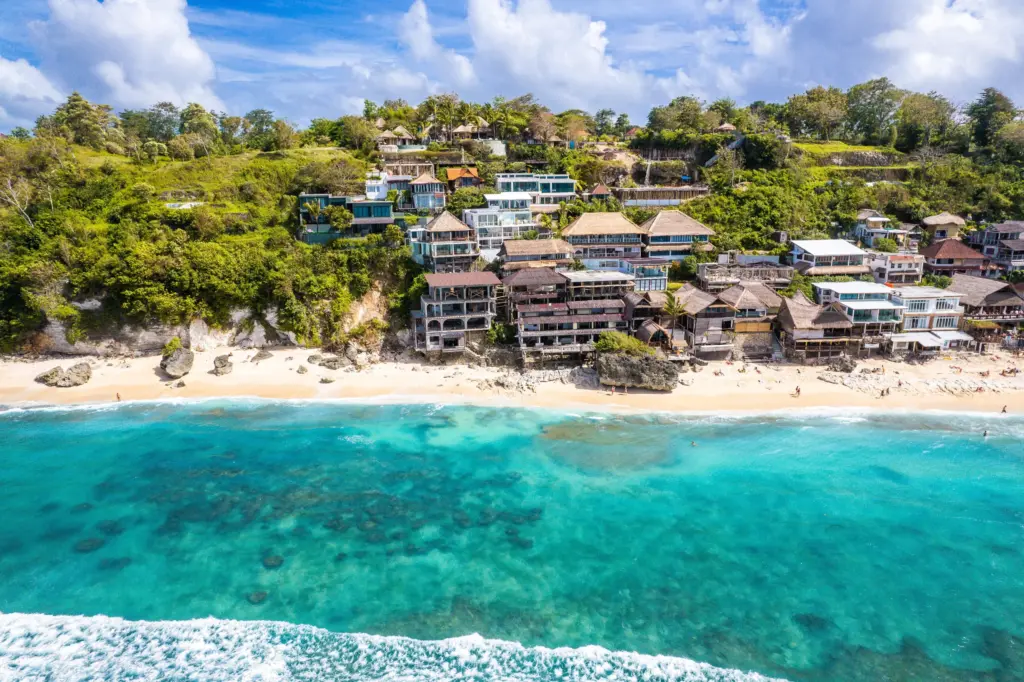
The action followed long-standing disputes over building permits and land use. Officials stated that many of the structures, from cafes and homestays to bars and shops, sat within a protected coastal zone and were built without proper authorisation. The land, they emphasised, belongs to the Badung Regency, and any development must follow strict spatial planning and environmental regulations. Several warnings had reportedly been issued in previous years, but with compliance still lacking, crews moved in to dismantle the buildings.
Because of Bingin’s location, heavy machinery could not easily be used. Demolition teams relied on manual tools to work their way down the cliffside, removing timber, roofing, and walls piece by piece. The process was as visible as it was emotional – many business owners had invested years into their properties, and local families faced the sudden loss of income.
Reactions have been intense. Surfers and travellers lamented the loss of the rustic charm that made Bingin feel different from more commercialised areas. High-profile voices from the surf world criticised the demolitions, worried that the area’s soul could be replaced by large-scale, impersonal projects. Authorities, however, have denied that this is a prelude to luxury resort development. Instead, they say the goal is to create a legally compliant, environmentally sustainable beachfront that still benefits the local community.
For now, Bingin Beach stands at a turning point. The sand and waves remain, but the cliffside is in transition. Local leaders have suggested that community input will shape the next phase, though concrete plans have yet to be finalised. Whether Bingin returns as a low-key surf hub, evolves into a more regulated tourist precinct, or takes an entirely new direction will depend on how these promises and policies unfold in the months ahead.
Uluwatu in One Breath
Uluwatu is cliffs, coves and a horizon that will not quit. It is reef breaks and quiet beaches, yoga decks and Kecak chants, espresso in the morning and grilled fish on the sand by evening. The region rewards travellers who prefer quality over quantity and presence over hurry. Choose a base that suits your rhythm, eat well at places that care about ingredients, and plan your days around tide, light and wind. Do that and Uluwatu will give you the version of Bali that lives in your head long after the flight home. Wander Beyond Ordinary!
